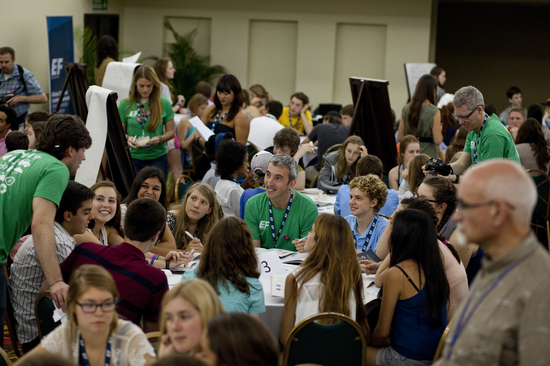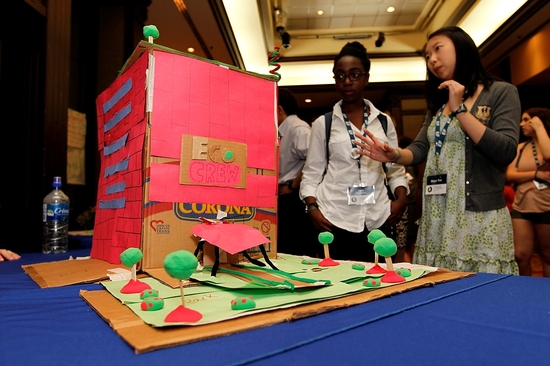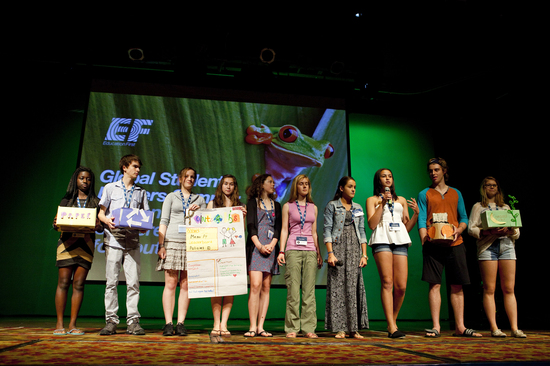By JP Riedel, Student at Dover-Sherborn High School in Massachusetts
For thousands of years humans have been masters of their surroundings, creating structures and cities of mammoth proportions. Though it wasn't until the industrial revolution that human urbanization really took a toll on the environment. Now our cities require vast amounts of land and resources to run and provide for an ever-growing population and those resources are not infinite. This is a problem not for future generations but the generation of today -- my generation. At the 2013 Global Student Leaders Summit in Costa Rica, 450 students separated into 44 different groups in an 'Innovative Workshop' to collaborate and develop ideas to improve how we live environmentally.
The groups were split into four categories: food, waste management, transportation, and urban development. Over the course of 4 hours spread over two days, students used the 'Design Thinking Process' to work together and develop creative and innovative solutions. The 'Design Thinking Process' is a six step collaborative process that is used by big companies such as Apple to develop new ideas and products. The stages are as follow: 1 Identify (What are the different ways we can consider the implications of this scenario?), 2 Empathy (Who is the target audience affected by the problem and how do they feel?), 3 Define (What is your team's design challenge?), 4 Ideate (What is your solution? How do you solve the task at hand? Think outside the box), 5 Prototype (What does your solution look like?), 6 Evolve (How will you share this idea with the world? How can you improve your idea?). Through this ingenious yet simple process students were able to come up with some very creative ideas.
Groups placed into the category of urban development were given a challenge, to take an empty plot of land in a city and put it to use in the most effective and efficient way possible. My group, the "Eco-Crew" came up with the idea of creating a tower with multiple uses and would be self-sufficient. The windows would have transparent solar panels that would generate electricity for the residents. The structure also features hanging gardens and a garden on the roof of the building to that residents can provide food for themselves and sell the extra to pay for some of the building's expenses.
Another group, Team Sloth Student Center, focused their urban development plan around athletes. The athletic center is electrically sustainable through solar panels, stationary equipment such as bicycles that generate electricity when in use, and socket balls. Socket balls are soccer balls with a magnet inside a copper sphere inside a soccer ball. When the ball is kicked or thrown, the magnet spins and generates electricity, which is stored in a small battery. The Sloth center also features a pond, garden, and small farm. Goat milk and dairy products, along with fish from the pond, and vegetables from the garden, are grown and sold at a local farmers market to fund the center. Students can learn about farming and families can purchase healthy locally grown food without the high price tag of that comes with preserving and shipping food from far away farms.
While team Sloth Student Center focused on athletes, team Envirotopia focused on local families by designing a multipurpose building. Underground parking for cars and bikes, a gym with stationary equipment that generates electricity, and a rec center for local families in the area are among the first few floors of the building. Higher up the building contains a cafeteria that serves food grown from gardens on the roof and window gardens. Window gardens are plants in containers that hang outside windows and catch water to hydrate the plant. The roof garden uses thick soil to help insulate the building and all crops grown save the building money on food expenses. Also on the roof are solar panels that aid in the money saving advantages to this building.
If 450 students can come up with such innovative ideas today, imagine what society can come up with tomorrow. Most if not all of the technologies implemented in these buildings exist today. So why don't we have eco-friendly cities? Well for one thing it's very hard to tear down a city and build from scratch. But what we can do is make small changes in how we live through recycling or using eco-friendly light bulbs or installing one or two solar panels here and there. Getting locally involved helps too. People can change the world one small step at a time, all we need to do is get active, think global, and act local.
All of us who traveled to Costa Rica are excited to share our ideas with students from around the world through EF's Summit! Follow us on Twitter at #EFSummit or on Facebook at www.Facebook.com/EFSummit.
About the Global Student Leaders Summit Series
This post is part of a series produced by The Huffington Post and EF Education First, in recognition of the 2013 EF Global Student Leaders Summit in Costa Rica (April 20 and 21, 2013). Each year, the EF Global Student Leaders Summit brings together hundreds of high school students and teachers from around the world for experiential learning tours and a leadership and innovation conference to help the next generation of leaders understand and solve critical global issues. Learn more about EF Education First and the Global Student Leaders Summit.




